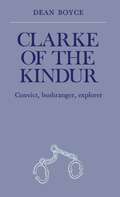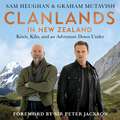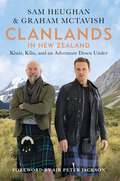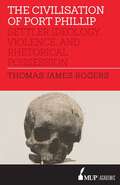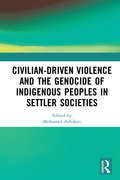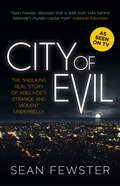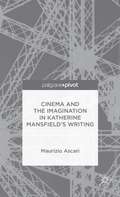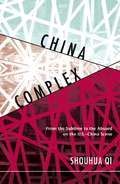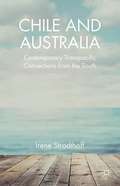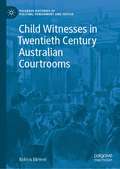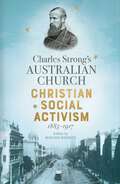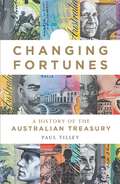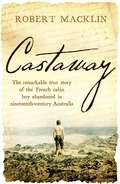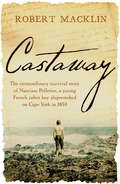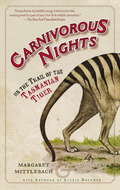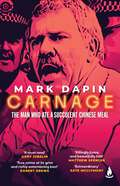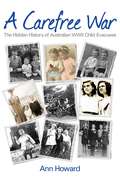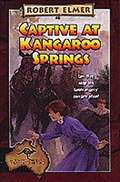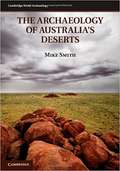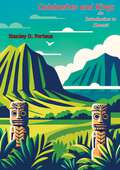- Table View
- List View
Clarke of the Kindur: Convict, bushranger, explorer
by Dean BoyceTransported convict George Clarke absconded in the early 1800s and went far into the then unexplored wilderness of northern New South Wales. There, thought by the Aborigines to be a 'ghost', he lived with them for four years, integrating into their lives and later leading them on raids to steal the white men's cattle. On eventual capture he claimed to have crossed the continent and to have discovered a great inland river, the 'Kindur'—a 'desired blessing' of the colonists—which prompted Major Thomas Mitchell's expeditions into the area. This biography traces Clarke's eventful history from his transportation from England in 1824 for robbery, his escape and life with the Kamilaroi Aborigines, his ventures into bushranging, his capture and subsequent imprisonment on Norfolk Island, and death on the public gallows in Van Diemen's Land.
Clanlands in New Zealand: Kiwis, Kilts, and an Adventure Down Under
by Sam Heughan Graham McTavish*With a foreword by Sir Peter Jackson*Buckle up, grab a dram, and get ready for another unforgettable wild ride.They're back! Stars of Outlander, Sam Heughan and Graham McTavish are no strangers to the rugged beauty of Scotland. But this time they're setting their sights on a new horizon: New Zealand.Join our intrepid Scotsmen on their latest epic adventure across The Land of the Long White Cloud in this thrilling follow-up to Clanlands. Setting out to explore a country that Graham calls home, and that Sam has longed to visit, these sturdy friends immerse themselves in all that New Zealand has to offer: stunning landscapes, rich history, world-class food and drink, and - much to Graham's mounting anxiety and Sam's deep satisfaction - famously adrenaline-fuelled activities! As ever there's not nearly enough space in their trusty camper van and with plenty of good-natured competition and tormenting to go around, Sam and Graham's friendship is put to the test once again. Along the way we learn about the length and breadth of this jewel of the Southern Seas, exploring the fascinating story of its people while testing the very limits of Graham's sanity.Like the very best buddy movie sequel, this latest instalment is full of unforgettable experiences and loveable characters and promises to be an even more memorable ride with two of the most entertaining travel companions around.So, say goodbye to your inhibitions and kia ora to New Zealand like you've never seen it before.(p) 2023 Hachette Audio US
Clanlands in New Zealand: Kiwis, Kilts, and an Adventure Down Under
by Sam Heughan Graham McTavish*With a foreword by Sir Peter Jackson*Buckle up, grab a dram, and get ready for another unforgettable wild ride.They're back! Stars of Outlander, Sam Heughan and Graham McTavish are no strangers to the rugged beauty of Scotland. But this time they're setting their sights on a new horizon: New Zealand.Join our intrepid Scotsmen on their latest epic adventure across The Land of the Long White Cloud in this thrilling follow-up to Clanlands. Setting out to explore a country that Graham calls home, and that Sam has longed to visit, these sturdy friends immerse themselves in all that New Zealand has to offer: stunning landscapes, rich history, world-class food and drink, and - much to Graham's mounting anxiety and Sam's deep satisfaction - famously adrenaline-fuelled activities! As ever there's not nearly enough space in their trusty camper van and with plenty of good-natured competition and tormenting to go around, Sam and Graham's friendship is put to the test once again. Along the way we learn about the length and breadth of this jewel of the Southern Seas, exploring the fascinating story of its people while testing the very limits of Graham's sanity.Like the very best buddy movie sequel, this latest instalment is full of unforgettable experiences and loveable characters and promises to be an even more memorable ride with two of the most entertaining travel companions around.So, say goodbye to your inhibitions and kia ora to New Zealand like you've never seen it before.
Clanlands in New Zealand: Kiwis, Kilts, and an Adventure Down Under
by Sam Heughan Graham McTavish*With a foreword by Sir Peter Jackson*Buckle up, grab a dram, and get ready for another unforgettable wild ride.They're back! Stars of Outlander, Sam Heughan and Graham McTavish are no strangers to the rugged beauty of Scotland. But this time they're setting their sights on a new horizon: New Zealand.Join our intrepid Scotsmen on their latest epic adventure across The Land of the Long White Cloud in this thrilling follow-up to Clanlands. Setting out to explore a country that Graham calls home, and that Sam has longed to visit, these sturdy friends immerse themselves in all that New Zealand has to offer: stunning landscapes, rich history, world-class food and drink, and - much to Graham's mounting anxiety and Sam's deep satisfaction - famously adrenaline-fuelled activities! As ever there's not nearly enough space in their trusty camper van and with plenty of good-natured competition and tormenting to go around, Sam and Graham's friendship is put to the test once again. Along the way we learn about the length and breadth of this jewel of the Southern Seas, exploring the fascinating story of its people while testing the very limits of Graham's sanity.Like the very best buddy movie sequel, this latest instalment is full of unforgettable experiences and loveable characters and promises to be an even more memorable ride with two of the most entertaining travel companions around.So, say goodbye to your inhibitions and kia ora to New Zealand like you've never seen it before.
Civilisation of Port Phillip: Settler ideology, violence, and rhetorical possession
by Thomas James RogersPort Phillip's free settlers often said that they were civilising a wilderness. The truth was that the occupied country already had people, laws, politics, and economies. What did 'civilisation' mean to the free settlers? And what was the relationship between civilising and violence? The Civilisation of Port Phillip tracks the violent history of the first years of British settlement in the Port Phillip District, now the state of Victoria. It illuminates the underlying free-settler rhetoric that advocated and abetted violence on the frontier. For the first time, we hear the settlers tell us in their own words what the civilisation of Port Phillip really involved. Frontier violence in Port Phillip involved Aboriginal peoples, convicts, free settlers and colonial officials. This history shows how the lives of these different people interconnected in early Port Phillip, in unlikely friendships, dire misunderstandings, and fatal clashes. It paints a vivid picture of the period drawn from archival records, a thorough re-reading of older histories, and new ideas in the scholarship of violence. As well as sheep and firearms, free settlers brought Enlightenment ideas about civilisation to Port Phillip. When these European ideas were coupled with Australian frontier experience, they manifested in an exterminatory attitude towards people deemed undesirable in the coming colony. The Civilisation of Port Phillip shows how free-settler rhetoric, law, and systems of classification reinforced and sought to justify the violence of the frontier.
Civilian-Driven Violence and the Genocide of Indigenous Peoples in Settler Societies
by Mohamed AdhikariExisting studies of settler colonial genocides explicitly consider the roles of metropolitan and colonial states, and their military forces in the perpetration of exterminatory violence in settler colonial situations, yet rarely pay specific attention to the dynamics around civilian-driven mass violence against indigenous peoples. In many cases, however, civilians were major, if not the main, perpetrators of such violence. The focus of this book is thus on the role of civilians as perpetrators of exterminatory violence and on those elements within settler colonial situations that promoted mass violence on their part.
City of Evil: The Truth About Adelaide's Strange and Violent Underbelly
by Sean Fewster'Sean Fewster discovers that a dark truth lurks behind Adelaide's murder capital myth' - Adelaide AdvertiserThey call Adelaide the `city of churches?. What they forget is that every church has a graveyard -- and every graveyard is full of skeletons.Adelaide, an elegantly designed, civilised city, where the inhabitants are known for their love of the arts, good food and fine wine, is also the place where many of Australia?s most bizarre and macabre crimes have taken place. The cases in this book show that Adelaide truly does have another side: from the murder of a transvestite, pro-wrestling truck driver by his two lesbian lodgers (who worked as prostitutes) during an argument over a camera; to the prosecution of an elderly couple by the RSPCA for keeping, in frightful conditions and almost starved to death, a collection of 120 stray dogs and six pigs. This book is more than a collection of some of the most attention-grabbing, shocking and puzzling cases from the past ten years: it also looks at why it might be that so many have happened in this sunny, conservative, unassuming state capital. 'a collection of macabre murders, rapes, torture and robbery, all occurring in Adelaide, the "City of Churches"...sensational and gruesome' - Courier Mail'This book is not for the squeamish, but if you love true crime stories then this is right up there with the best of them' - Toowoomba Chronicle
Cinema and the Imagination in Katherine Mansfield’s Writing
by Teresa A. FisherUsing silent cinema as a critical lens enables us to reassess Katherine Mansfield's entire literary career. Starting from the awareness that innovation in literature is often the outcome of hybridisation, this book discusses not only a single case study, but also the intermedia exchanges in which literary modernism at large is rooted.
China's Grand Strategy and Australia's Future in the New Global Order
by Geoff RabyThe US-dominated world order has been replaced by a multipolar order, but its closest allies such as Australia seek to retain American primacy, adding dangerously to heightened geopolitical competition between the dominant and the ascendant power, China. Where the first great power shift of the twenty-first century was across the Pacific from the United States to China, the next great power shift is now underway from Russia to China. Putin&’s invasion of Ukraine has depleted Russia of its power and influence across Eurasia, while China&’s continues to grow. As China consolidates its power across Eurasia, it can turn to project power globally, just as the US did at the turn of the last century when it cemented its power over the western hemisphere. Diplomatically, Australia is forced to navigate an increasingly unfamiliar world where the guarantor of its security is no longer the sole dominant power, while China remains its most important economic partner. Is Australia agile enough to walk the fine line of supporting US primacy in the Asia–Pacific while providing a bulwark against China&’s ambitions? In China&’s Grand Strategy and Australia&’s Future in the New Global Order Geoff Raby believes something has to give – and unpacks the ramifications for Australia.
China Complex
by Shouhua QiFor more than a century, the United States and China have been partners in an occasionally graceful--but often awkward--cultural-political tango. In this insightful narrative, Shouhua Qi, part of a new generation of scholars whose life experiences in China and the West serve as the basis for an acute analysis of cross-cultural perceptions, weaves literary and cultural criticism together with journeys across time, politics, and popular culture. Part memoir, Qi reveals the China complex as a manifestation of the search for meaning at many levels: personal, national, and global. With the future of the U.S. and China so intertwined now more than ever before, Qi's cogent assessment of the interpersonal foundations of the US-China relationship in the twenty-first century is a must-read.
Chile and Australia
by Irene StrodthoffExploring bilateral narratives of identity at a socio-discursive level from 1990 onwards, this book provides a new approach to understanding how Chile and Australia imagine and discursively construct each other in light of the bilateral Free Trade Agreement signed in 2008.
Child Witnesses in Twentieth Century Australian Courtrooms (Palgrave Histories of Policing, Punishment and Justice)
by Robyn BlewerThis book considers the law, policy and procedure for child witnesses in Australian criminal courts across the twentieth century. It uses the stories and experiences of over 200 children, in many cases using their own words from press reports, to highlight how the relevant law was – or was not - applied throughout this period. The law was sympathetic to the plight of child witnesses and exhibited a significant degree of pragmatism to receive the evidence of children but was equally fearful of innocent men being wrongly convicted. The book highlights the impact ‘safeguards’ like corroboration and closed court rules had on the outcome of many cases and the extent to which fear – of children, of lies (or the truth) and of reform – influenced the criminal justice process. Over a century of children giving evidence in court it is `clear that the more things changed, the more they stayed the same’.
Charles Strong's Australian Church: Christian Social Activism, 1885-1917
by Marion MaddoxIn the optimistic years preceding Federation in 1901, the Melbourne-based Australian Church emerged as a progressive Christian movement to serve a brand-new nation. Galvanising many members of Melbourne's social and political elite, activist Reverend Dr Charles Strong imagined the Australian Church becoming the national church, while addressing a broad social and political reform agenda, inspired by both theological and social liberalism. Their approach was described as 'progressive', 'liberal', 'radical' and 'socialist'. Strong and his wife, Janet, founded or led organisations for causes ranging from peace to penal reform. They fought for urban slum improvements, rural village settlements, childcare and adult education, the minimum wage and women's suffrage. Some organisations endure today; others left lasting legacies in Australian methods of addressing social inequality. Bringing together leading scholars of history, politics and religion, Charles Strong's Australian Church celebrates the church's radicalism, while taking account of debates and obstacles on the path to social reform.
Changing Fortunes: A History of the Australian Treasury
by Paul TilleyTreasury has been at the centre of every major economic policy issue the Australian Government has faced, its role evolving from the government's bookkeeper at Federation in 1901 to the economic policy advising agency it is today. Throughout its history Treasury has been a robust and stable institution with a consistent market-oriented economic framework - but its policy influence has waxed and waned. It has supported reformist Treasurers such as Keating and Costello, and been a voice of caution when political imperatives have pushed governments down economically damaging paths. At times, though, Treasury advice has been ignored and it has been pushed out into the cold. Amidst the political chaos of recent times, Treasury has been dragged closer to government and become a less effective policy adviser. The consequent lack of a consistent government economic reform narrative over the last decade is plain for all to see. Changing Fortunes tracks Treasury's history since Federation, with a focus on the modern era since its 1976 split with Finance.
Castaway: The remarkable true story of the French cabin boy abandoned in nineteenth-century Australia
by Robert Macklin'Macklin recounts, with beautiful detail, the following years of Narcisse's life and his transformation . . . a great read for anyone interested in Australia and its overlooked history'Ronan Breathnach, Irish Examiner 'A truly remarkable account drawing upon a version Pelletier gave when he eventually returned to his native France and also on anthropological studies of the Daintree people.' Piers Akerman, Daily Telegraph, Sydney 'An unforgettable tale of transformation and upheaval.'Stuart McLean, Daily Telegraph, SydneyA young boy abandoned in an alien landscape thousands of miles from home is adopted by local people and becomes one of them, welcomed into their community, marrying a wife and raising a child. After seventeen years, he is stolen back to his 'real' life, where he has another family, but dreams constantly of what he has left behind.This is the remarkable true story of a French cabin boy Narcisse Pelletier who, after disembarking from his ship the Saint-Paul with the rest of its crew in search of drinking water, found himself separated from his shipmates and in the end abandoned on the north coast of Queensland, Australia. Narcisse was adopted by an Aboriginal group who welcomed him as one of their own for seventeen years, during which time he had a family of his own. In 1875, though, he was kidnapped by the brig John Bell and was returned eventually to his family in Saint-Gilles, France, where he became a lighthouse keeper. Robert Macklin makes skilful use of Narcisse's own memoir Chez les sauvages along with new research to tell this extraordinary story.Robert is a Queenslander so knows the terrain and the people of the area in which Narcisse was left behind. Through Noel Pearson's Cape York Institute, he has arranged to meet descendants of the people who took the French cabin boy in and who know the stories of his time in Australia. Robert has also had access to a great deal of material on the early history of the Cape through the Australian National Library. He has drawn on the significant resources of the Australian Institute of Aboriginal and Torres Strait Islander Studies (AIATSIS) in Canberra on Aboriginal culture and history in Queensland and the Cape. In addition, he has made use of Narcisse Pelletier's own writings, including his account of his time in Australia, as well as several contemporaneous accounts of the Kennedy expedition to the area, including one from a member of the party. The author has made several trips to Cape York and one to Saint-Gilles and Saint-Nazaire in France.
Castaway: The extraordinary survival story of Narcisse Pelletier, a young French cabin boy shipwrecked on Cape York in 1858
by Robert MacklinIn 1858, 14-year-old Narcisse Pelletier sailed from Marseilles in the French trader Saint-Paul. With a cargo of Bordeaux wine, they stopped in Bombay, then Hong Kong, and from there they set sail with more than 300 Chinese prospectors bound for the goldfields of Ballarat and Bendigo. Around the eastern tip of New Guinea, however, the ship became engulfed in fog, struck reefs and ran aground. Scrambling aboard a longboat, the survivors undertook a perilous voyage, crossing almost 1000 kilometres of the Coral Sea before reaching the shores of the Daintree region in far north Queensland, where, abandoned by his shipmates and left for dead, Narcisse was rescued by the local Aboriginal people. For seventeen years he lived with them, growing to manhood and participating fully in their world - until in 1875 he was discovered by the crew of a pearling lugger and wrenched from his Aboriginal family. Taken back to his 'real' life in France, he became a lighthouse keeper, married and had another family, all the while dreaming of what he had left behind...Drawing from firsthand interviews with Narcisse after his return to France and other contemporary accounts of exploration and survival, and documenting the spread of European settlement in Queensland and the brutal frontier wars that followed, Robert Macklin weaves an unforgettable tale of a young man caught between two cultures in a time of transformation and upheaval.
Carnivorous Nights: On the Trail of the Tasmanian Tiger
by Margaret Mittelbach Michael CrewdsonPacking an off-kilter sense of humor and keen scientific minds, authors Margaret Mittelbach and Michael Crewdson take off with renowned artist Alexis Rockman on a postmodern safari. Their mission? Tracking down the elusive Tasmanian tiger. This mysterious, striped predator was once the world’s largest carnivorous marsupial. It had a pouch like a kangaroo and a jaw that opened impossibly wide to reveal terrifying choppers. Tragically, this rare and powerful animal was hunted into extinction in the early part of the twentieth century. Or was it? Journeying first to the Australian mainland and then south to the wild island of Tasmania, these young naturalists brave a series of bizarre misadventures and uproarious wildlife encounters in their obsessive search for the long-lost beast. From an ancient cave featuring an aboriginal painting of the tiger to a lab in Sydney where maverick scientists are trying to resurrect the animal through cloning, this intrepid trio comes face-to-face with blood-sucking land leeches and venomous bull ants, a misbehaving wallaby who invades their motel room, and a crew of flesh-eating, bone-crunching Tasmanian devils gorging on roadkill. They bond with trappers, bushwackers, and wildlife experts who refuse to abandon the tiger hunt, despite the paucity of evidence. Sifting through local myths, bar-room banter, and historical accounts, these environmental detectives sweep readers into a world where platypus’ swim, kangaroos roam, and a large predator with a pouch was–or perhaps still is–queen of the jungle. Filled with Alexis Rockman’s stunning drawings of flora and fauna–-made from soil, wombat scat, and the artist’s own blood–Carnivorous Nights is a hip and hilarious account of an unhinged safari, as well as a fascinating portrayal of a wildly unique part of the world.
Carnage: A succulent Chinese meal, Mr Rent-a-Kill and the Australian Manson murders
by Mark DapinMillions have been entertained by the viral video of a man being arrested after a &‘succulent Chinese meal&’. But when Mark Dapin investigated, it emerged that this man's story went to the heart of the Australian underworld. A true crime cult classic in the making. Whether you know it as the &‘succulent Chinese meal&’ video, or &‘democracy manifest&’, chances are you have seen the video of baritone larrikin Jack Karlson getting arrested outside a Brisbane Chinese restaurant in 1991. The Guardian called it &‘perhaps the pre-eminent Australian meme of the last 10 years&’. When Karlson called crime writer Mark Dapin out of the blue, though, Dapin hadn&’t heard of him. But there was enough that intrigued him about this theatrical outlaw to continue the conversation. Over the following months emerged a dark and complex past. It turned out that Karlson had been in the background of many notorious incidents in late-twentieth century Australian crime, from collaborating with infamous prison-playwright Jim McNeil to befriending hitman Christopher Dale Flannery (Mr Rent-a-Kill). But most shockingly of all, Karlson&’s life story led Dapin to shed new light on a number of unsolved murders, by two serial killers.The result is an extraordinary, deeply revealing portrait of Australian crime from the 60s to the 2010s – a portrait of carnage. &‘Mark Dapin could never be accused of glorifying crime, but he is guilty as sin for understanding it. Inhabited by flawed humans, filled with violence, humour, tears and dreams, Carnage is a classic Australian crime story.&’ Gary Jubelin, author of I Catch Killers 'True crime at its grim and richly entertaining best, and – let&’s face it – its truest.&’ Robert Drewe, author of The Shark Net &‘If ever there was a book crammed with colourful villains who are &“mad, bad and dangerous to know,&” it&’s definitely Mark Dapin&’s extraordinary book, Carnage.&’ Kate McClymont, author of He Who Must Be Obeid &‘Carnage is a window into Australian mayhem, killingly funny and beautifully told. Dapin finds pathos in a twisted world.&’ Matthew Spencer, author of Black River &‘Carnage begins by probing what seems a minor curiosity – an internet meme centred on a colourful character – then takes a turn into the lives of traumatised youths hurled without care or thought into brutalising reformatories. From there they graduate to rorts, robberies, violence. Bleak lives interspersed with occasional forays into squaresville – spouses, kids, even jobs – and attempts at betterment via theatre and literature. A unique, deeply felt take on the Australian underworld.&’ Peter Doyle, author of Crooks Like Us &‘The moment I start reading anything by Mark Dapin I&’m captivated, intrigued and engaged for the entire journey. There is no finer writer documenting the history and characters of Australian criminality.&’ Stuart Coupe
Carefree War: The Hidden History of Australian WWII Child Evacuees
by Ann HowardDuring World War II Australia was under threat of invasion. Could Australia be invaded by the Japanese? Even with the heavy censorship by the government many certainly thought so. Stunned families had followed the bombings and atrocities of war that were taking place in Europe, and the nation was gripped by fear that the danger would soon be on their doorstep. The Japanese appeared to be looming closer; there were submarines in Sydney Harbour, Japanese planes flying overhead and harassment on our coastline. Australians were fearful for their safety. Anxious parents made decisions to protect their children, with or without government sanction. Small children, some just out of babyhood, were sent away, often unaccompanied, by concerned parents to friends, relatives, or even strangers living in ‘safer’ parts of the country. Many had little comprehension of what was happening and thought they were going on a holiday to the country. The history of these child evacuees in Australia remains largely hidden and their experiences untold. Author Ann Howard, who was evacuated with her mother from the UK during World War II, is setting the records straight. A combination of extensive research and the first-hand stories of the evacuees captures the mood of the time and the social and political environment that they lived in.
Captive At Kangaroo Springs (Adventures Down Under #2)
by Robert ElmerBook 2 in the Adventures Down Under for middle-grade readers. Bushrangers take Patrick's sister hostage, then Patrick is captured. Can they find a way to stop the bounty hunters' terrible plan?
Canadians and Their Pasts
by David Northrup Margaret Conrad Gerald Friesen Jocelyn Létourneau D. A. Muise Kadriye Ercikan Peter SeixasWhat role does history play in contemporary society? Has the frenetic pace of today's world led people to lose contact with the past? A high-profile team of researchers from across Canada sought to answer these questions by launching an ambitious investigation into how Canadians engage with history in their everyday lives. The results of their survey form the basis of this eye-opening book.Canadians and Their Pasts reports on the findings of interviews with 3,419 Canadians from a variety of cultural and linguistic communities. Along with yielding rich qualitative data, the surveys generated revealing quantitative data that allows for comparisons based on gender, ethnicity, migration histories, region, age, income, and educational background. The book also brings Canada into international conversation with similar studies undertaken earlier in the United States, Australia, and Europe.Canadians and Their Pasts confirms that, for most Canadians, the past is not dead. Rather, it reveals that our histories continue to shape the present in many powerful ways.
Cambridge concise histories: A Concise History of Australia
by Stuart MacintyreAustralia is the last continent to be settled by Europeans, but it also sustains a people and a culture tens of thousands years old. For much of the past 200 years the newcomers have sought to replace the old with the new. This book tells how they imposed themselves on the land, and brought technology, institutions and ideas to make it their own. It relates the advance from penal colony to a prosperous free nation and illustrates how, as a nation created by waves of newcomers, the search for binding traditions was long frustrated by the feeling of rootlessness, until it came to terms with its origins. The third edition of this acclaimed book recounts the key factors - social, economic and political - that have shaped modern-day Australia. It covers the rise and fall of the Howard government, the 2007 election and the apology to the stolen generation. More than ever before, Australians draw on the past to understand their future.
Cambridge World Archaeology
by Mike SmithThis is the first book-length study of the archaeology of Australia's deserts, one of the world's major habitats and the largest block of drylands in the southern hemisphere. Over the last few decades, a wealth of new environmental and archaeological data about this fascinating region has become available. Drawing on a wide range of sources, The Archaeology of Australia's Deserts explores the late Pleistocene settlement of Australia's deserts, the formation of distinctive desert societies, and the origins and development of the hunter-gatherer societies documented in the classic nineteenth-century ethnographies of Spencer and Gillen. Written by one of Australia's leading desert archaeologists, the book interweaves a lively history of research with archaeological data in a masterly survey of the field and a profoundly interdisciplinary study that forces archaeology into conversations with history and anthropology, economy and ecology, and geography and earth sciences.
Calabashes and Kings: An Introduction To Hawaii
by Stanley D. PorteusEmbark on a captivating journey through the rich history, vibrant culture, and breathtaking landscapes of Hawaii with Stanley D. Porteus's Calabashes and Kings: An Introduction to Hawaii. This comprehensive and engaging book offers readers a detailed exploration of the Hawaiian Islands, providing a deep understanding of their unique heritage and enduring allure.Stanley D. Porteus, a distinguished psychologist and longtime resident of Hawaii, combines his keen observational skills with extensive research to present a vivid portrait of the islands. Calabashes and Kings delves into the origins and evolution of Hawaiian society, from its ancient Polynesian roots to its complex interactions with Western explorers, missionaries, and settlers.The book covers a wide array of topics, including the traditional customs and beliefs of the Hawaiian people, the significance of the calabash in daily life, and the revered status of the islands' monarchs. Porteus highlights the impact of historical events such as the arrival of Captain Cook, the rise and fall of the Hawaiian Kingdom, and the eventual annexation by the United States.Porteus’s narrative is enriched with captivating stories and anecdotes that bring the history and culture of Hawaii to life. He explores the natural beauty of the islands, from the majestic volcanoes and lush rainforests to the pristine beaches and vibrant coral reefs. His detailed descriptions provide a sensory experience that transports readers to this Pacific paradise.This book is an essential read for anyone interested in Hawaii, whether you are a traveler seeking to deepen your understanding of the islands or a student of history and culture. Calabashes and Kings serves as both an informative guide and a heartfelt tribute to the spirit of Hawaii and its people.
Bye, Baby Bunting
by Day KeeneThis is no ordinary who-dun-it. The story tells of a diabolical conspiracy in which ‘proof’ of marital infidelity becomes a weapon of murder... The discovery, in the boot of her car, of the corpse of an amorous multi-millionaire catapults a young wife into a murder trial. When Jennifer St John, who is seven months pregnant, is charged with the murder of family friend, Tom Bligh, her husband, Paul, hires the best attorney in town.
